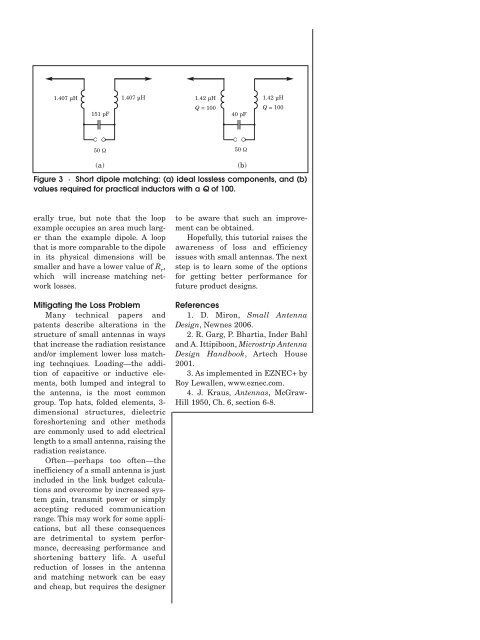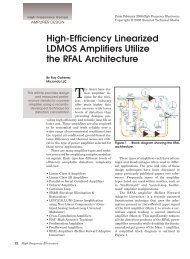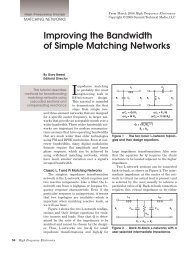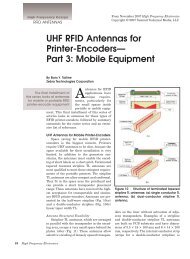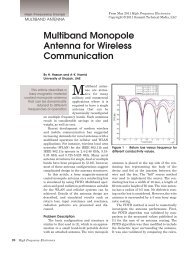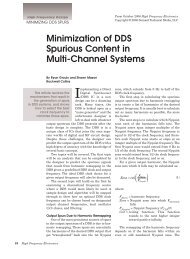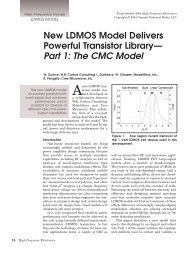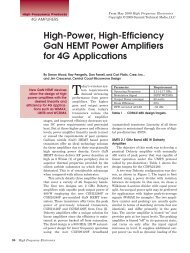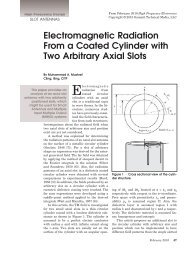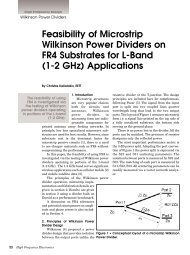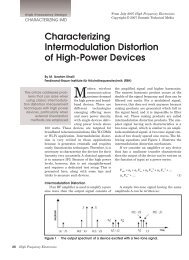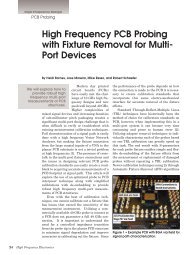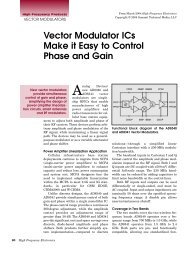Basic Principles of Electrically Small Antennas - High Frequency ...
Basic Principles of Electrically Small Antennas - High Frequency ...
Basic Principles of Electrically Small Antennas - High Frequency ...
You also want an ePaper? Increase the reach of your titles
YUMPU automatically turns print PDFs into web optimized ePapers that Google loves.
1.407 µH 1.407 µH 1.42 µH<br />
Q = 100<br />
151 pF 40 pF<br />
1.42 µH<br />
Q = 100<br />
50 Ω 50 Ω<br />
(a)<br />
Figure 3 · Short dipole matching: (a) ideal lossless components, and (b)<br />
values required for practical inductors with a Q <strong>of</strong> 100.<br />
(b)<br />
erally true, but note that the loop<br />
example occupies an area much larger<br />
than the example dipole. A loop<br />
that is more comparable to the dipole<br />
in its physical dimensions will be<br />
smaller and have a lower value <strong>of</strong> R r<br />
,<br />
which will increase matching network<br />
losses.<br />
Mitigating the Loss Problem<br />
Many technical papers and<br />
patents describe alterations in the<br />
structure <strong>of</strong> small antennas in ways<br />
that increase the radiation resistance<br />
and/or implement lower loss matching<br />
technqiues. Loading—the addition<br />
<strong>of</strong> capacitive or inductive elements,<br />
both lumped and integral to<br />
the antenna, is the most common<br />
group. Top hats, folded elements, 3-<br />
dimensional structures, dielectric<br />
foreshortening and other methods<br />
are commonly used to add electrical<br />
length to a small antenna, raising the<br />
radiation resistance.<br />
Often—perhaps too <strong>of</strong>ten—the<br />
inefficiency <strong>of</strong> a small antenna is just<br />
included in the link budget calculations<br />
and overcome by increased system<br />
gain, transmit power or simply<br />
accepting reduced communication<br />
range. This may work for some applications,<br />
but all these consequences<br />
are detrimental to system performance,<br />
decreasing performance and<br />
shortening battery life. A useful<br />
reduction <strong>of</strong> losses in the antenna<br />
and matching network can be easy<br />
and cheap, but requires the designer<br />
to be aware that such an improvement<br />
can be obtained.<br />
Hopefully, this tutorial raises the<br />
awareness <strong>of</strong> loss and efficiency<br />
issues with small antennas. The next<br />
step is to learn some <strong>of</strong> the options<br />
for getting better performance for<br />
future product designs.<br />
References<br />
1. D. Miron, <strong>Small</strong> Antenna<br />
Design, Newnes 2006.<br />
2. R. Garg, P. Bhartia, Inder Bahl<br />
and A. Ittipiboon, Microstrip Antenna<br />
Design Handbook, Artech House<br />
2001.<br />
3. As implemented in EZNEC+ by<br />
Roy Lewallen, www.eznec.com.<br />
4. J. Kraus, <strong>Antennas</strong>, McGraw-<br />
Hill 1950, Ch. 6, section 6-8.


